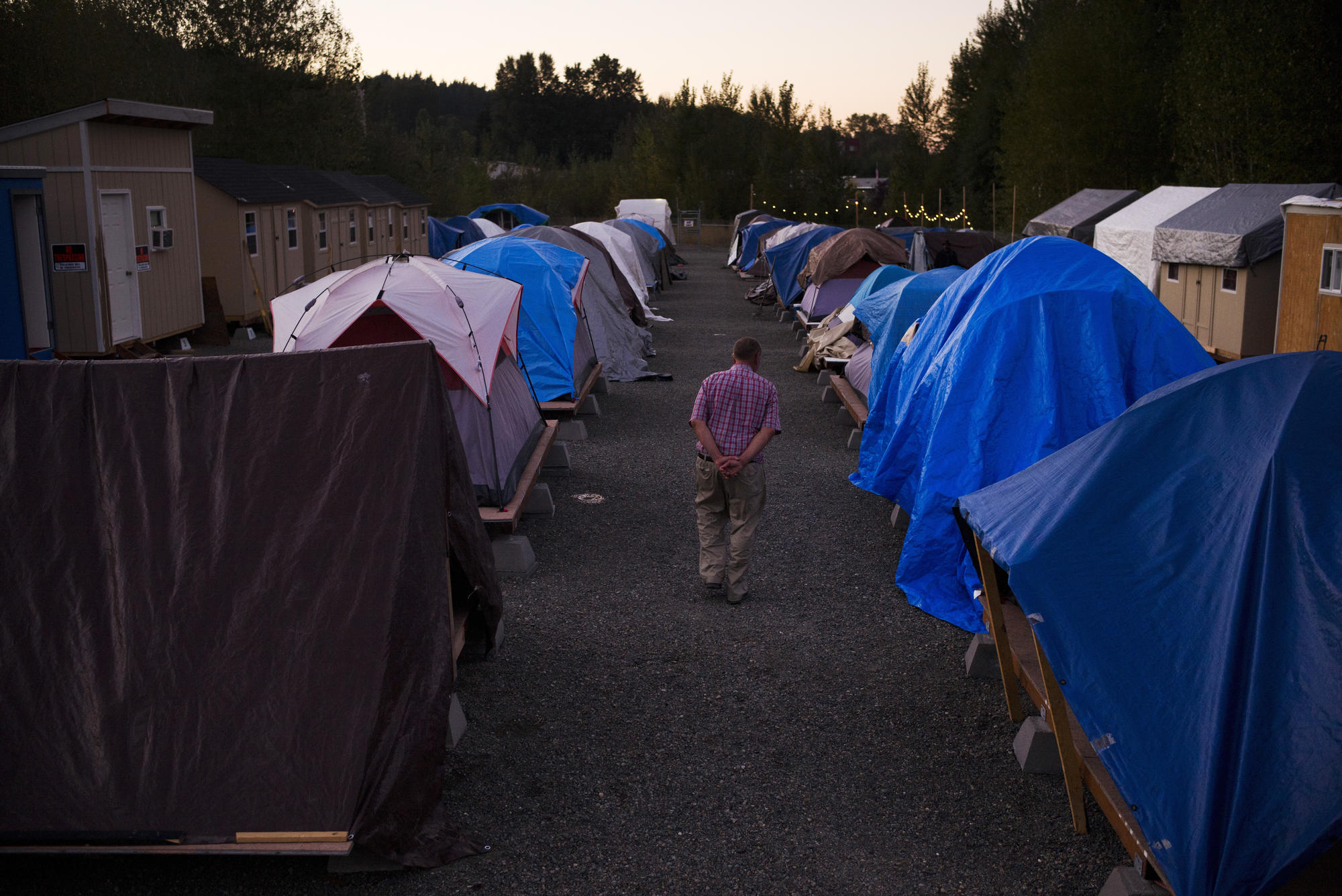Pay a truly living wage
When business owners, large or small, private sector or nonprofit, declare their business would be hurt if forced to pay employees enough to afford the basics of food and shelter, they are telling us their business model depends on the poverty of their workers. This puts the burden of making up the gaps in food and shelter on the rest of society.
Employers must pay a real livable wage; otherwise they contribute to homelessness and must not be licensed to do business in our region. Simple. We the people issue a license to any individual or group wanting to start a business. That license is their agreement to live by the laws we have enacted to strengthen and protect our community. If human beings are part of the environment, their access to habitat must be as important as what is needed for salmon or orca to thrive.
Editor's note: This is part two of a two-part series on homelessness. Read part one here.
This is why minimum wage laws must reflect the true cost of living in our region. A wage of $15 an hour is obviously insufficient. If we choose not to believe this, we, as the society that allows employers to pay less, must fully accept the cost of making up the difference and stop whining about it.
Calculate the monthly salary at $15 per hour. One-third, about $840, is the share federal guidelines use to determine housing affordability. Check Zillow.com, apartments.com, Craigslist or any home sales or rental website to see what’s available in Seattle. Although they will show nearly 13,100 available rentals, all you will find for that price are single rooms in shared houses or spaces with the square footage of a large storage facility. In fact, a 10-by-20-foot storage space, at $170 to $230 monthly, is much cheaper.
Since wages and housing affordability are so closely linked in reality, they must be linked in public policy. Minimum wages must be tied to a real cost of living. The easiest way I can think of to do this is to index minimum wage and all salary increases to cost-of-housing increases in our region. When housing costs go up 5%, salaries must be made to match. This not only ensures livable wages, but also gives employers incentive to monitor housing costs. It creates an alliance between employers and their employees in maintaining housing affordability.
Everyone with salary responsibility must be held accountable for ensuring the lowest paid employees under their supervision are compensated enough to afford housing. This might result in one fewer annual vacation for people up the economic ladder, or a smaller salary. For those at the bottom of the ladder, it means shelter; for society, it means fewer tents or RVs on the roadside.
Responsible hiring, responsible corporate citizenship
We need to ensure employers promising new jobs in our region are also promising those new jobs to the people already in our region. Whether paying bonuses to HR consultants or staff for each local hire, hosting a local jobs fair before publicly posting jobs or adding weighting in their hiring process to give local candidates extra points, employers must exhibit an active commitment to our region before and after receiving such public benefits as tax breaks.
If our region doesn’t possess the skills a business requires, one would first question why the business is located here. If the business would be an asset to our region, it is advantageous for them to invest in education and government agencies developing people locally with those skills. The investment ultimately would save the business from paying relocation costs, at least, not to mention rehiring costs once transplants discover they don’t like the weather, or the Seattle Freeze, after all.
As we have seen over the past decade, importing thousands of additional workers has an impact on all aspects of our social infrastructure: housing, transportation, education, environment and the economy. We must be able to gauge when the population of our region has exceeded the limits that our region’s resources can support. Clogged midday traffic, the exodus of thousands of former residents who can no longer afford to live in Seattle or its near suburbs, along with polluted skies reminiscent of Los Angeles smog in the 1970s, depleted salmon, the dead zone in Puget Sound all indicate we are close.
When an employer says it’s adding over 500 jobs within a year, it needs to provide an environmental impact statement and mitigation plan showing what percentage of their increased workforce will be imported from outside the region. If a strong majority, say 85%, is from the Puget Sound area, no mitigation plan would be needed. Otherwise, employers must explain whether additional housing will be required and show how they will financially mitigate for any potential displacement resulting from bringing new workers into the region. Will they build new housing? Will they subsidize housing costs for newcomers? If so, how will they return balance to those who may be displaced by being undercut in the newcomers’ search for housing? Will they mitigate the social erasure of gentrification by providing training and resources to newcomers about the region’s history so they can better integrate themselves into existing social structures?
Finally, let’s require any regional employer planning on expansion to hire first from among those without housing. Here’s an excellent opportunity for the Seattle Metropolitan Chamber of Commerce, and all the smaller regional chambers, to show true partnership in problem-solving. Leaders and participants in organizations like Leadership Tomorrow, Leadership Eastside, Project Lead and Rotary can use their individual and collective influence to encourage companies to build a culture of welcome for those coming in from the economic cold. Because people of color and LGBTQI people often face additional housing and employment discrimination, all of these civic organizations must encourage their partners and members to create and implement plans toward a welcoming environment, especially free of racism, sexism, homophobia and transphobia.
Fortify the social safety net
The state’s Workers Compensation Fund must be expanded to include a housing voucher program to deal with the impact of layoffs or business closures resulting from employers' inept decisions (e.g. Washington Mutual) or displacement by being priced out by redevelopment. This can be used to provide stability while the unemployed worker seeks new work or the dislodged renter finds new home. Just as employers pay into Workers Comp, developers whose projects will result in potential displacement should pay into the voucher program.
In the story of the Evanses, told in my prior column, it was a change in building ownership that triggered housing instability. Landlords should be required to deposit the equivalent of at least half of one month’s rent each year into escrow accounts for each tenant. If the property is sold and the tenant forced to move, the money in the account would enable the tenant to have enough money to find other housing. For example, a tenant paying $840 a month, living in an apartment for five years, would receive $2,100. Think about it: Most landlords couldn’t afford to own the property without the renter. The renter is part of making an investment in the property. The statute would carry civil and criminal penalties, including monetary remuneration and jail time for landlords who don’t comply.
These solutions will help prevent homelessness for many families. Housing people currently without homes will be more complicated, but it’s not impossible.
Invest in and diversify Navigation teams
The city-run Navigation teams are tasked with outreach to homeless encampments. Their current mission is incoherent and seemingly focused on moving homeless people out of sight rather than solving their homelessness. There aren’t enough teams, nor are they diverse enough to serve the wide range of unhoused people. An effective Navigation team would consist of a social worker, housing specialist, employment specialist, and nurse or physician’s assistant and be led by someone who has been homeless. Housing specialists would have access to a database of available permanent housing and could offer shelter immediately. Employment specialists would work directly with WorkSource and companies with significant local presence like Indeed or LinkedIn to catalog skills and find matching jobs. No encampments would be uprooted. The only role of police would be as silent escorts to the team.
Current navigators could even identify potential new team members who are without housing so they could be trained and hired as Navigation team members. As the proposal for a new Regional Homelessness Authority indicates, their knowledge and experience would be invaluable in understanding how to approach and serve various homeless communities with respect.
For those individuals not choosing to move into permanent housing, there is no reason the city and county can’t provide trash pickup and other support services the Navigation teams identify as needed.
You too can help prevent homelessness
Institutions aren’t the only ones who can participate. Many of the emails I’ve received in response to the first column ask, “What can I do? As an individual I feel so helpless.” First, stop being an individual. Get together with co-workers and friends and talk about salary distribution in your workplaces. Learn the formulas for salary distribution within your company. Ask human resources for a breakdown of the percentage of total salaries allocated to C-level executives, managers, supervisors, line or professional staff and support staff. Talk with hiring managers and human resources staff about your interest in mentoring a new hire who may have once been homeless. Be open with friends and family about your own struggle to stay on the safe side of the homeless ledge.
Are you a shareholder in a publicly traded company or a partner in an LLC? Ask for a breakdown of salary plus benefits showing percentage of total for each employment level. Also ask for a breakdown of hourly rates paid to contractors and the percentage of total contract payments versus total employee salaries. Gather with other shareholders or partners and use the appropriate formal process to inform the company you are willing to forgo payouts until wages are made livable for those at the bottom of the organizational hierarchy. Put a limit on the time period you will wait for results and offer consequences if action isn’t taken.
If you are media or involved in political organizations, ask every political candidate who is a business owner if the lowest wages they pay are enough for that employee to have a reliable place to call home. Ask them what benefits they provide their employees, especially related to income-busters like health care.
Give your financial support and, most importantly, your vote to candidates who have a clear analysis of homelessness and proposals putting the responsibility on those who have the actual power to make a difference. When they get elected and try to make those changes, stand beside them; fight for them.
We are not helpless. We have created this society brick by brick. There are deep cracks in its foundation. The vast economic disparity we see has been festering for a very long time. We can fix it but, like a misdiagnosed disease, it will take commitment and determination to see the treatment through and, for some of us, a change in lifestyle.
There are no easy fixes here. In fact, every proposal requires sacrifice: time, money, energy, resources, maybe even status and power. We have to prioritize. Participate in getting people into homes or live comfortably and wag your fingers at those hit by misfortune. That is, of course, until a health crisis, economic downturn, or social upheaval comes along and throws your life into chaos. What, then, would you want people to do for you?


